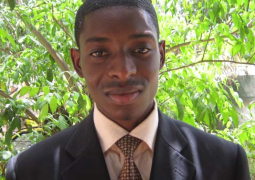Breast Cancer in Men
Why don’t we hear about breast cancer in men as much as we hear about breast cancer in women? In fact, men get the same types of breast cancers that women do, although cancers involving the milk producing and storing regions of the breast are rare. An estimated 2,190 cases of breast cancer will be diagnosed in men in 2012.
Dr Azadeh, our health adviser, and senior lecturer who is also a senior consultant in Obstetrics & Gynaecology at UTG is this week focusing on a rare cancer disease in men as “breast cancer in men” and explain about the causes, symptoms, diagnose and treatment facilitate here in the Gambia.
Dr Azadeh how true is breast cancer in men?
In fact, only about 1 in 100 breast cancers affect men and only about 10 men in a million will develop breast cancer.
Even though men don’t have breasts like women, they do have a small amount of breast tissue. In fact, the “breasts” of an adult man are similar to the breasts of a girl before puberty, and consist of a few ducts surrounded by breast and other tissue. In girls, this tissue grows and develops in response to female hormones, but in men -- who do not secrete the same amounts of these hormones -- this tissue doesn’t develop.
Breast cancer in men is uncommon. This is possibly due to their smaller amount of breast tissue and the fact that men produce less hormones such as estrogens that are known to affect breast cancers in women.
Which men are more likely to get breast cancer?
It is rare for a man under age 35 to get breast cancer. The likelihood of a man developing breast cancer increases with age. Most male breast cancers are detected between the ages of 60 to 70 years. Other risk factors of male breast cancer include:
• Family history of breast cancer in a close female relative.
• History of radiation exposure of the chest.
• An abnormal enlargement of breasts (called gynecomastia) in response to drug or hormone treatments, or even some infections and poisons.
• A rare genetic condition called Klinefelter’s syndrome.
• Severe liver disease.
• Diseases of the testicles such as mumps orchites, a testicular injury, or an undescended testicle.
How serious is breast cancer in men?
Doctors used to think that breast cancer in men was a more severe disease than it was in women, but it now seems that for comparably staged breast cancers, men and women have similar outcomes.
The major problem is that breast cancer in men is often diagnosed later than breast cancer in women. This may be because men are less likely to be suspicious of an abnormality in that area. In addition, their small amount of breast tissue is harder to feel -- making it more difficult to catch these cancers early, and allowing tumours to spread more quickly to the surrounding tissues.
What are the symptoms of breast cancer in men?
Symptoms of breast cancer in men are very similar to those in women. Most male breast cancers are diagnosed when a man discovers a lump on his chest. However, unlike women, men tend to go to the doctor with more severe symptoms that may include bleeding from the nipple and abnormalities in the skin above the cancer. At that point the cancer may have already spread to the lymph nodes.
The most common symptom of male breast cancer is a painless lump or swelling behind the nipple. Other symptoms can include a discharge from the nipple or a lump or thickening in the armpit. Although most men diagnosed with breast cancer are older than 65, breast cancer can appear in younger men. For this reason, any breast lump in an adult male is considered abnormal and should be checked out by a doctor.
How is male breast cancer diagnosed?
Most male breast cancer is diagnosed with a biopsy to investigate a lump or thickening in the breast or armpit. Because there is no routine screening for breast cancer and a breast lump does not usually cause pain, sometimes breast cancer isn’t discovered until it has spread to another area of the body and is causing other symptoms.
How is it treated?
The main treatment for male breast cancer is surgery to remove the breast and sentinel lymph node biopsy (sampling). Because most men do not have very much breast tissue, breast-conserving surgery is not used.
There hasn’t been much research on breast cancer treatments in men, because male breast cancer is so uncommon. But breast cancer in men is similar to breast cancer in women, and some of the same treatments may be used. These include radiation, chemotherapy, hormone therapy, and targeted therapy.
Chemotherapy may be used after surgery to reduce the chance that breast cancer will come back somewhere else in the body. If the breast cancer is sensitive to certain hormones (meaning that the cells have estrogens/progesterone receptors), male breast cancer may be treated with a hormone-blocking agent. Male breast cancer usually responds very well to chemotherapy or hormone
Differences from female breast cancer
There are significant differences between male and female breast cancer. Lesions are easier to find in men due to the smaller breast size; however, lack of awareness may postpone seeking medical attention. The presence of gynecomastia may mask the condition. The diagnosis is made later in men—at age 67 on average—than in women with their average at 63. Lesions are less contained in men as they do not have to travel far to infiltrate skin, nipple, or muscle tissue.[3] Thus, lesions in men tend to be more advanced. Indeed, almost half of male breast cancer patients are stage III or IV. In familial cases, male carriers are at risk
Treatment largely follows patterns that have been set for the management of postmenopausal breast cancer. The initial treatment is surgical and consists of a modified radical mastectomy dissection or lumpectomy and radiation therapy with similar treatment results as in women. Also, mastectomy with sentinel lymph node biopsy is a treatment option. In men with node-negative tumours, adjuvant therapy is applied under the same considerations as in women with node-negative breast cancer. Similarly, with node-positive tumours, men increase survival using the same adjuvant as affected women, namely chemotherapy and other hormonal therapy. There are no controlled studies in men comparing adjuvant options. In the vast majority of men with breast cancer hormone receptor studies are positive, and those situations are typically treated with hormonal therapy.
Locally recurrent disease is treated with surgical excision or radiation therapy combined with chemotherapy. Distant spiriting are treated with hormonal therapy, chemotherapy, or a combination of both. Bones can be affected either by advanced or weakened from hormonal therapy.
People afraid of Cancer
Some people who don’t have cancer worry more about cancer than those who do
A hypochondriac is someone who, experiencing certain symptoms immediately imagines that he/she is suffering from the most serious condition that could explain those symptoms. We call such people health worriers.
The health worriers we see in our clinic tend to worry that they may have a disease that is not evident right now, but might be lurking unseen, and is likely to be fatal. There aren’t very many such diseases. Some of these patients concentrate on the possibility of being infected with serious diseases or even AIDS.
It is not clear just what a patient afraid of cancer is really afraid of. Some people say they are afraid of dying, that is, the process of dying. Some people are afraid of being dead. Their real fears are hard to elicit, but may range from mutilation, abandonment, and helplessness to other such existential fears.
For further information and concern for your health visit any Government Hospital RVTH or Clinics, NGO and private clinics, “THE POINT” health section, call DR Azadeh and Peter Gomez live health show every Tuesday from 6-7 at West Coast Radio and DR Azadeh on week days between 3-6 pm Tel. 7774469 , E- Mail azadehhassan@yahoo.co.uk.



